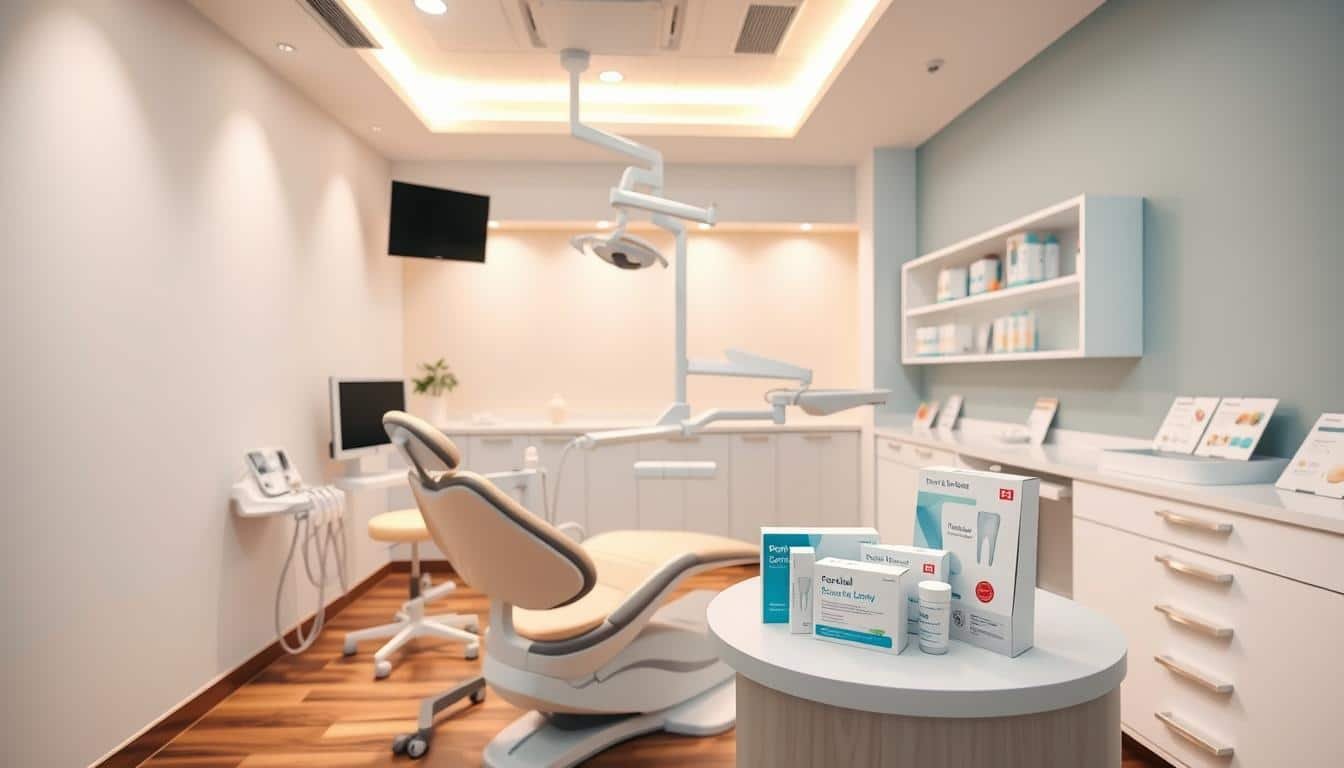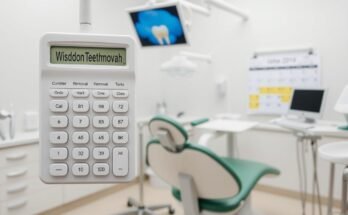Insurance: Teeth Bleaching Insurance Coverage: What to Know-2025
Ever wondered if your dental insurance covers teeth whitening? Many people ask this when they want a brighter smile.
The truth is that dental insurance coverage for teeth bleaching can be unclear. We’ll look into what’s usually covered, the costs, and other options you might consider.
Key Takeaways
- Dental insurance plans often consider teeth whitening a cosmetic procedure, which may not be covered.
- Professional in-office teeth whitening treatments may have some insurance coverage, but the reimbursement amount can vary.
- At-home teeth whitening kits are generally not covered by dental insurance.
- Understanding your plan’s deductibles, copays, and annual maximums is crucial for managing out-of-pocket costs.
- Exploring alternative teeth whitening options, such as over-the-counter products or lifestyle changes, can help achieve a whiter smile without breaking the bank.
Understanding Dental Insurance Coverage
Understanding dental insurance can be hard, but it’s key to get the most from your teeth whitening benefits. Dental insurance plans group services into different levels. Each level has its own coverage amount.
Also Read: Understanding Insurance Endorsement Benefits 2024
Covered vs. Non-Covered Procedures
Dental insurance covers many basic and preventive services like check-ups and fillings. But, cosmetic procedures like teeth whitening are often not covered. It’s vital to check your plan to see if teeth whitening is included.
Preventive, Basic, and Major Services
- Preventive Services: Routine cleanings, exams, and X-rays are usually covered fully, at 100%.
- Basic Services: Fillings and minor restorations are covered at 80%.
- Major Services: Complex procedures like crowns are covered at 50%.
Knowing these levels helps you budget for costs and plan for teeth whitening.
| Service Category | Typical Coverage Level |
|---|---|
| Preventive Services | 100% |
| Basic Services | 80% |
| Major Services | 50% |
“Knowing the ins and outs of your dental insurance plan can make a big difference when it comes to getting the most value out of your benefits.”
Teeth Bleaching Insurance Coverage: What to Know
Dental insurance can be tricky when it comes to teeth bleaching. The coverage varies a lot between different providers and plans. Knowing how teeth bleaching insurance works can help you make smart choices about your dental care.
Whether teeth bleaching is covered depends on its purpose. If it’s needed for health reasons, like fixing discoloration from certain meds or dental work, it might be covered. But if it’s just for looks, it’s likely not covered.
Insurance companies have their own rules for teeth bleaching. Some might pay for in-office whitening, while others won’t. At-home kits can also have different rules, with some plans covering them and others not.
It’s crucial to check your dental insurance plan closely. Talk to your provider to know what’s covered. This way, you can plan for any costs and choose the best dental care for you.
| Dental Insurance Coverage for Teeth Bleaching | Covered | Not Covered |
|---|---|---|
| Medically Necessary Bleaching | ✓ | |
| Cosmetic Teeth Whitening | ✓ | |
| In-Office Whitening Treatments | Partial Reimbursement | Exclusion |
| At-Home Whitening Kits | Allowance or Reimbursement | No Coverage |
Understanding teeth bleaching insurance can help you use your dental insurance wisely. This way, you can get the best care for your smile.
“Your smile is one of the first things people notice about you, so it’s important to keep it looking its best. Understanding your dental insurance coverage for teeth bleaching can help you make the most of your benefits and achieve the smile you’ve always wanted.”
Professional In-Office Teeth Whitening
Looking for a quick and lasting teeth whitening solution? Professional in-office treatments might be what you need. These are done by licensed dentists and can give you results that home products can’t match.
Also Read: OpenHousePerth.net Insurance Tips: Unlock Success.
Eligibility and Reimbursement Policies
Insurance coverage for teeth whitening can be tricky. The rules for dental insurance and insurance reimbursement depend on many things.
Professional teeth whitening is usually seen as cosmetic. So, it’s not covered by most dental insurance plans. But, there are cases where it might be covered, like if the discoloration is from medicine or a health issue.
| Procedure | Typical Coverage | Reimbursement |
|---|---|---|
| In-Office Teeth Whitening | Often not covered | Limited or none |
| Teeth Whitening Due to Medical Condition | May be covered | Dependent on plan |
It’s key to check your dental insurance plan. Talk to your dentist about your options. This way, you’ll know what you might have to pay for teeth whitening treatments.
At-Home Teeth Whitening Kits
At-home teeth whitening kits are a popular choice for brightening smiles. They are cheaper and easier to use than professional treatments. But, do they fit into your budget and dental insurance?
These kits come as trays, strips, or gels. They use peroxide to remove stains and make your teeth whiter. You can find them at drugstores, supermarkets, and online, making them easy to get.
But, insurance coverage for these kits is not clear. They are seen as cosmetic and might not be covered. This means you’ll have to pay for them yourself.
It’s smart to check with your insurance about at-home whitening kits. Some plans might help with the cost, while others won’t. Knowing this can help you plan your budget better.
| Product | Average Cost | Dental Insurance Coverage |
|---|---|---|
| Crest 3D White Strips | $30-$50 | Generally not covered |
| Colgate Optic White Toothpaste | $5-$10 | Generally not covered |
| Opalescence Whitening Trays | $100-$200 | May be partially covered in some cases |
Choosing at-home teeth whitening kits should be a thoughtful decision. Consider your budget, dental insurance, and what you want for your smile. Knowing the pros and cons can help you make the best choice for you.
Cosmetic Procedures and Dental Insurance
Dental procedures often blur the line between cosmetic and medically necessary. Teeth whitening is a good example. Knowing the difference between cosmetic and necessary treatments is key when dealing with teeth whitening and other cosmetic procedures.
Defining Cosmetic vs. Medically Necessary
Cosmetic procedures make your teeth or smile look better but don’t fix health issues. Teeth whitening is a cosmetic treatment to enhance your smile. Medically necessary procedures, like fillings or crowns, are for your oral health.
The main difference is the treatment’s purpose. Cosmetic procedures are chosen, while necessary ones fix dental problems. This affects how much dental insurance covers different treatments.
“Cosmetic procedures are not typically covered by dental insurance, as they are considered optional and not essential for maintaining good oral health.”
It’s vital to check your dental insurance plan to see what’s covered. This helps you choose the right treatments and manage costs.
Out-of-Pocket Costs for Teeth Whitening
Teeth whitening costs can vary a lot, depending on the treatment you choose. Knowing these costs helps you plan your dental budget better.
Professional In-Office Teeth Whitening
Professional teeth whitening at a dentist’s office can cost between $300 and $1,000 or more. The price depends on the dentist’s location, how much whitening you need, and the treatment method.
At-Home Teeth Whitening Kits
At-home whitening kits are cheaper, costing between $20 and $100 or more. These kits usually come with trays or strips for home use. But, they might not give the same results as professional treatments.
| Whitening Treatment | Average Cost |
|---|---|
| Professional In-Office | $300 – $1,000+ |
| At-Home Kits | $20 – $100+ |
Dental insurance might help pay for some whitening treatments. But, you’ll still have to pay a lot out of pocket. Always check with your insurance to see what they cover and any teeth whitening dental insurance limits.
“Investing in your smile can have a profound impact on your confidence and overall well-being. While the costs may seem high, the long-term benefits of a brighter, healthier smile are often well worth the investment.”
Alternatives to Teeth Whitening
Teeth whitening is popular for a brighter smile, but it’s not for everyone. There are other dental treatments and procedures that can make your teeth look better. Some of these might be covered by your dental insurance.
Dental bonding is a good alternative to teeth whitening. It uses a tooth-colored resin to cover up stains. This makes your smile look better. It’s also more affordable and can be done in one visit.
- Dental veneers are thin, custom shells that hide stains and chips.
- Tooth reshaping smooths and reshapes teeth for a better look.
- Ceramic crowns cover up damaged teeth, making them look natural again.
The dental insurance for these options might vary. Always check with your provider to know what’s covered and what you might have to pay for.
Looking into alternatives to teeth whitening can help you find a smile solution that fits your budget and insurance. Talk to your dentist to find the best option for you.
Maximizing Your Dental Benefits
Understanding dental insurance is key. Knowing about deductibles and copays helps you use your coverage wisely. This is especially true for teeth whitening and other dental services. By getting the most from your policy, you can cut down on out-of-pocket costs.
Understanding Deductibles and Copays
Your dental deductible is what you pay first. After that, your insurance covers a part of the cost, known as your copay. Knowing these terms helps you plan better. This way, you get the best value from your dental insurance plan.
| Dental Insurance Term | Definition |
|---|---|
| Deductible | The amount you must pay out-of-pocket before your insurance coverage begins. |
| Copay | The percentage of the remaining costs that your insurance plan covers after you’ve met your deductible. |
Stay informed about your dental insurance benefits. Plan your dental treatments wisely. This way, you can get the most from your coverage. And you’ll spend less on out-of-pocket costs for things like teeth whitening.
Conclusion
In this article, we’ve looked into teeth bleaching insurance coverage. We’ve covered what makes you eligible, the costs, and other ways to get a brighter smile. Knowing your dental insurance and all your options helps you make smart choices for your smile and wallet.
Whether you choose professional teeth whitening or at-home kits, you now know how to find the best deal. Remember, keeping up with dental visits and good oral care is key to keeping your smile bright.
Being informed about your dental insurance and options lets you control your oral health. With the knowledge from this article, you’re ready to make the right choices for your teeth. You can now get the smile you’ve always wanted.
FAQ
What is typically covered by dental insurance when it comes to teeth bleaching?
Dental insurance for teeth bleaching varies a lot. Most plans don’t cover it because it’s seen as cosmetic. But, some might pay part of it if it’s needed for health reasons.
What is the difference between preventive, basic, and major dental services?
Dental insurance groups services into three types: preventive, basic, and major. Preventive care, like cleanings, is covered well. Basic care, like fillings, gets some coverage. Major care, like crowns, gets the least coverage or costs more.
How do insurance providers determine if teeth whitening is considered a covered or non-covered service?
Insurance checks if teeth whitening is for health or looks. If it’s for health, like fixing stains, it might be covered. But, if it’s just for looks, it’s usually not covered.
What factors influence the reimbursement policies for professional in-office teeth whitening treatments?
Reimbursement for in-office whitening depends on several things. These include the treatment, the provider, and your insurance. Some plans might cover part of it, while others won’t.
Are at-home teeth whitening kits generally covered by dental insurance?
At-home whitening kits are not covered by dental insurance. They are seen as cosmetic. The cost of these kits can vary a lot, based on the brand and strength.
How is the distinction between cosmetic and medically necessary dental procedures determined?
The difference between cosmetic and necessary dental care is clear. Necessary care fixes health issues, like cavities or gum disease. Cosmetic care, like whitening, is for looks and not covered.
How can I estimate the out-of-pocket costs for teeth whitening?
Costs for teeth whitening depend on the treatment and your insurance. Consider your deductible, copays, and the treatment cost. Talking to your dentist and insurance can help estimate the costs.
What are some alternatives to teeth whitening that may be covered by dental insurance?
If whitening is not covered, there are other options. Treatments like bonding, veneers, or orthodontics might be covered. Talk to your dentist to find affordable options.
How can I maximize my dental benefits when it comes to teeth whitening or other treatments?
To use your dental insurance well, know about deductibles and copays. Check your policy for whitening and cosmetic care rules. Work with your dentist to find the best, affordable treatment.
Sajjad Hossain is an experienced writer on StatusCaption.xyz, specializing in insurance, business ideas, money management, and investment. With a passion for simplifying complex financial topics, [Author Name] provides clear and actionable insights to help readers make informed decisions in their financial journey. Committed to delivering expert advice and practical tips, Sajjad Hossain aims to empower readers to achieve their financial goals confidently and strategically.




